History

 There are places in this world that have hidden places in them that might just surprise most people. At one time, these hidden places might have had a useful purpose, but later their usefulness was gone, and they were either closed up or removed altogether. The Brooklyn Bridge in New York City is one of those places. You can’t really remove a hidden place in a bridge, but you can close the hidden places up if they are no longer needed.
There are places in this world that have hidden places in them that might just surprise most people. At one time, these hidden places might have had a useful purpose, but later their usefulness was gone, and they were either closed up or removed altogether. The Brooklyn Bridge in New York City is one of those places. You can’t really remove a hidden place in a bridge, but you can close the hidden places up if they are no longer needed.
When the Brooklyn Bridge was built, portions of surrounding neighborhoods in Manhattan and Brooklyn had to be demolished in order to build the bridge’s two anchorage sections, which attach the bridge to land. This affected several local merchants more so than others, and because of that impact, the situation had to be addressed. To compensate local merchants and offset some of the bridge’s $15 million budget, wine cellars and other vaulted spaces were incorporated into the bridge’s design. The storage space that had once belonged to the merchants, had to be replaced with useable space, so several wine merchants and other alcohol sellers began renting the spaces in 1883, when the bridge was completed, and except for the Prohibition years, the cellars remained in operation until World War II.
The wine cellars were filled with wine before the Brooklyn Bridge was even operational. The cellars were the idea of bridge engineer John Roebling, and they were completed by his son Washington Roebling after John died. They were created as a solution to an alcohol problem, designed with the hoped that building the cellars would keep the wine dark, cool and secure. The cellars were huge. They are connected by a series of twisting tunnels named after French roads.
Prohibition brought a new era for the cellars. They were turned into newspaper storage areas. When Prohibition 
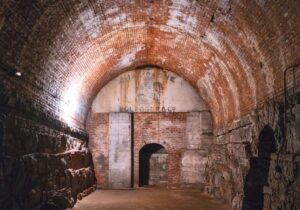 ended, they briefly reopened to the public, but World War II led the city of New York to take over permanent management of the cellars and close them to visitors. Since then, almost no one has seen them. The cellars remain empty and forgotten by the thousands of pedestrians and motorists who cross the Brooklyn Bridge every day. They are used for storage, and an occasional homeless person who finds their way inside.
ended, they briefly reopened to the public, but World War II led the city of New York to take over permanent management of the cellars and close them to visitors. Since then, almost no one has seen them. The cellars remain empty and forgotten by the thousands of pedestrians and motorists who cross the Brooklyn Bridge every day. They are used for storage, and an occasional homeless person who finds their way inside.
 We are all used to alternative forms of energy these days. From electric cars to solar heating to wind energy, things have changed some. One thing I had never heard of before, however, is a solar-powered airplane. Of course, the plane was built to promote green energy, and I don’t personally think that green energy is a totally feasible option…sorry if anyone disagrees. Nevertheless, someone came up with the idea of using solar energy for an airplane. I have to admit that the idea of a plane operating totally on solar energy is something that would make me a little apprehensive, nevertheless, one was developed. And it was successful too. A solar-powered airplane completing the 10th leg of it’s journey by landing in Arizona after a 16-hour flight from California in 2015. Now, admittedly, a normal plane could have made the trip in a couple of hours, so in that way, it was rather anticlimactic.
We are all used to alternative forms of energy these days. From electric cars to solar heating to wind energy, things have changed some. One thing I had never heard of before, however, is a solar-powered airplane. Of course, the plane was built to promote green energy, and I don’t personally think that green energy is a totally feasible option…sorry if anyone disagrees. Nevertheless, someone came up with the idea of using solar energy for an airplane. I have to admit that the idea of a plane operating totally on solar energy is something that would make me a little apprehensive, nevertheless, one was developed. And it was successful too. A solar-powered airplane completing the 10th leg of it’s journey by landing in Arizona after a 16-hour flight from California in 2015. Now, admittedly, a normal plane could have made the trip in a couple of hours, so in that way, it was rather anticlimactic.
The plane was the brain-child of Bertrand Piccard, who dreamed of an airplane of perpetual endurance…able to fly day and night without fuel. With the construction of this plane, that dream had been realized, and with the flight of co-founder Andre Borschberg’s flight, history had been made. Still, who has 16 hours to make that flight, when you can drive it in 12 hours. The spindly, single-seat experimental aircraft, dubbed Solar Impulse 2, arrived in Phoenix shortly before 9pm, following a flight from San Francisco that took it over the Mojave  Desert. The solar plane’s pilots were required to take up meditation and hypnosis in training, so they could stay alert for long periods.
Desert. The solar plane’s pilots were required to take up meditation and hypnosis in training, so they could stay alert for long periods.
The plane’s capacity was one…just the pilot in the tiny cockpit. Andre Borschberg, who alternated with fellow pilot Bertrand Piccard at the controls for each segment of what they hope will be the first round-the-world solar-powered flight. “I made it to Phoenix, what an amazing flight over the Mojave desert,” Borschberg said in a Twitter post. Borschberg was the pilot for the Japan-to-Hawaii trip over the Pacific last July, staying airborne for nearly 118 hours…shattering the prior record of 76 hours for a non-stop, solo flight set back in 2006 by the late Steven Fossett in his Virgin Atlantic Global Flyer. Solar Impulse 2 set new duration and distance records for solar-powered flight too.
Not all was picture-perfect with the venture, however. The project was dealt a setback when the Solar Impulse suffered severe battery damage, requiring repairs and testing that grounded it in Hawaii for nine months. After repairs were made, Piccard completed the trans-Pacific crossing, reaching San Francisco after a flight of nearly three days, more than three times the 18 hours Amelia Earhart took to fly solo from Hawaii to California in the 1930s. In many ways, the project would seem to be a failure, but the one real success it had was that the 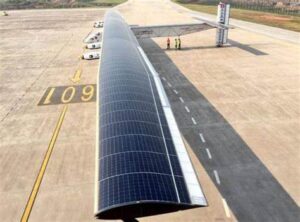 flights were made without fuel. Its four engines were powered solely by energy collected from more than 17,000 solar cells built into its wings. Surplus power is stored in four batteries during the day, to keep the plane aloft on extreme long-distance flights. The carbon-fiber plane, with a wingspan exceeding that of a Boeing 747 and the weight of a family car, is unlikely to set speed or altitude records. It can climb to 28,000 feet, and cruise at 34 to 62 miles per hour. It’s not something I think I would choose to fly in, but then it’s possible that down the road, when it isn’t an experimental plane, and it can carry more people, I might find myself traveling in just such a plane.
flights were made without fuel. Its four engines were powered solely by energy collected from more than 17,000 solar cells built into its wings. Surplus power is stored in four batteries during the day, to keep the plane aloft on extreme long-distance flights. The carbon-fiber plane, with a wingspan exceeding that of a Boeing 747 and the weight of a family car, is unlikely to set speed or altitude records. It can climb to 28,000 feet, and cruise at 34 to 62 miles per hour. It’s not something I think I would choose to fly in, but then it’s possible that down the road, when it isn’t an experimental plane, and it can carry more people, I might find myself traveling in just such a plane.
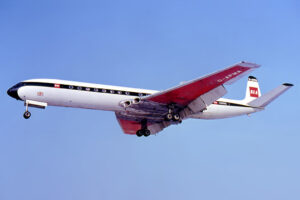 As planes became more and more common, it became evident that at some point, they were going to be used commercially. Still, I can’t imagine being on that first commercial flight. I doubt if it comes as a surprised that the first commercial flight in history occurred in the United States. What is surprising is that the flight took place on January 1, 1914, three years before the United States entered World War I. Planes weren’t commonly used forms of transportation in any arena, so a commercial flight is almost beyond imagination. Following that first flight, the Vickers Viscount emerged in 1948, as the first commercial airliner to use turboprop power. That plane was equipped with four Rolls-Royce Dart turboprop engines, the British aircraft had a pressurized cabin and was capable of carrying 40 to 65 passengers.
As planes became more and more common, it became evident that at some point, they were going to be used commercially. Still, I can’t imagine being on that first commercial flight. I doubt if it comes as a surprised that the first commercial flight in history occurred in the United States. What is surprising is that the flight took place on January 1, 1914, three years before the United States entered World War I. Planes weren’t commonly used forms of transportation in any arena, so a commercial flight is almost beyond imagination. Following that first flight, the Vickers Viscount emerged in 1948, as the first commercial airliner to use turboprop power. That plane was equipped with four Rolls-Royce Dart turboprop engines, the British aircraft had a pressurized cabin and was capable of carrying 40 to 65 passengers.
While I would have expected the world’s first commercial jet airliner to follow suit and come from the United States, it did not. The de Havilland DH.106 Comet, the world’s first commercial jet airliner, was actually developed and manufactured by de Havilland at its Hatfield Aerodrome in Hertfordshire, United Kingdom. The Comet 1 prototype first flew in 1949. It featured an aerodynamically clean design with four de Havilland Ghost turbojet engines buried in the wing roots, a pressurized cabin, and large square windows. It’s relatively quiet, comfortable passenger cabin and innovative design, made the plane commercially promising at its debut on this 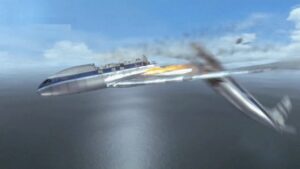 day, May 2, 1952. Unfortunately, within a year of entering service, the plane began to experience problems. Three Comets were lost within twelve months in highly publicized accidents, after suffering catastrophic in-flight break-ups. Two of the break-ups proved to be caused by structural failure resulting from metal fatigue in the airframe, a phenomenon not fully understood at the time. The third break-up was due to overstressing of the airframe during flight through severe weather. That flight might have had problems even if it had been a more advanced plane, because weather related crashes are still somewhat common today.
day, May 2, 1952. Unfortunately, within a year of entering service, the plane began to experience problems. Three Comets were lost within twelve months in highly publicized accidents, after suffering catastrophic in-flight break-ups. Two of the break-ups proved to be caused by structural failure resulting from metal fatigue in the airframe, a phenomenon not fully understood at the time. The third break-up was due to overstressing of the airframe during flight through severe weather. That flight might have had problems even if it had been a more advanced plane, because weather related crashes are still somewhat common today.
Due the the problems, the Comet was withdrawn from service and extensively tested. Design and construction flaws, including improper riveting and dangerous concentrations of stress around some of the square windows, were ultimately identified as the points of the fatigue. As a result, the Comet was extensively redesigned, with oval windows, structural reinforcements and other changes. Rival manufacturers meanwhile heeded the lessons learned from the Comet while developing their own aircraft. I guess there always has to be that one we learned from. Unfortunately, when people get scared about something, it is very hard to recover in the courts of public opinion.
 Sadly, sales of the Comet 1 never fully recovered after the crashes. The improved Comet 2 and the prototype Comet 3 culminated in the redesigned Comet 4 series which debuted in 1958 and did quite well, remaining in commercial service until 1981. Later, the Comet was adapted for military usage. It played a variety of military roles such as VIP, medical and passenger transport, as well as surveillance. In 1997, the last Comet 4 was used as a research platform, making its final flight later that year. The most extensive modification resulted in a specialized maritime patrol derivative, the Hawker Siddeley Nimrod, which remained in service with the Royal Air Force until 2011, over 60 years after the Comet’s first flight.
Sadly, sales of the Comet 1 never fully recovered after the crashes. The improved Comet 2 and the prototype Comet 3 culminated in the redesigned Comet 4 series which debuted in 1958 and did quite well, remaining in commercial service until 1981. Later, the Comet was adapted for military usage. It played a variety of military roles such as VIP, medical and passenger transport, as well as surveillance. In 1997, the last Comet 4 was used as a research platform, making its final flight later that year. The most extensive modification resulted in a specialized maritime patrol derivative, the Hawker Siddeley Nimrod, which remained in service with the Royal Air Force until 2011, over 60 years after the Comet’s first flight.
 Some holidays celebrate one thing and one thing only, but others, such as May Day, can have several meanings. When my sisters and I were children, May Day was a special day. Our mom, Collene Spencer would go to the story and buy candy. We made baskets out of construction paper and put candy in them. Then we would sneak around the neighborhood, hang the baskets on the front door of a neighbor and knock on the door. Then, we would run and hide. Sometimes they would catch us, and sometimes they would just yell out “thank you,” but they were always pleased that we though of them and did something nice for them.
Some holidays celebrate one thing and one thing only, but others, such as May Day, can have several meanings. When my sisters and I were children, May Day was a special day. Our mom, Collene Spencer would go to the story and buy candy. We made baskets out of construction paper and put candy in them. Then we would sneak around the neighborhood, hang the baskets on the front door of a neighbor and knock on the door. Then, we would run and hide. Sometimes they would catch us, and sometimes they would just yell out “thank you,” but they were always pleased that we though of them and did something nice for them.
Many people look at May Day as celebrating the beginning of the summer season, or at least the warmer part of Spring. It is a day when it seems like suddenly the flowers have all begun to bloom, the grass gets green, and the trees got their leaves. That is a great way to think about it, because for me Spring and Summer are the best times of the year. I love being able to get out and hike and just enjoy the warm weather. Some of the celebrations included a Maypole dance where ribbons were wrapped around a pole to create a work of art. The ribbons are multi-colored, so its like braiding them together. Its a great game for the kids…and a great welcome to Summer!!
In the United States, May first has another meaning…it is also Law Day. These days it is questionable as to how people  feel about that, but to me it is an important day. Our nation needs law and order, and I believe that most people would agree. Law Day is a day meant to reflect on the role of law in the foundation of the country and to recognize its importance for society. These days there are people who are against the police, except when they need one, and then suddenly the police are very important. I have and have had law enforcement officers in my family, and I can say that they are some of the most caring people I know. So to them I say Happy Law Day!! To everyone else, Happy May Day!!
feel about that, but to me it is an important day. Our nation needs law and order, and I believe that most people would agree. Law Day is a day meant to reflect on the role of law in the foundation of the country and to recognize its importance for society. These days there are people who are against the police, except when they need one, and then suddenly the police are very important. I have and have had law enforcement officers in my family, and I can say that they are some of the most caring people I know. So to them I say Happy Law Day!! To everyone else, Happy May Day!!
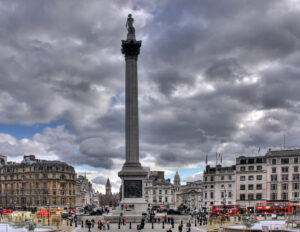 Protests are a common story these days, and the police are often kept busy for days trying to keep some kind of order. Not much has really changed in that arena. No nation is exempt from the possibility of violence breaking out because people feel they have been subjected to injustice…whether the facts bear out the belief or not. In 1926, miners across the United Kingdom went on strike. They were being subjected to an involuntary 13% wage cut, as well as an increase in weekly labor, and they were not planning to put up with it. When workers in other industries refused to work in solidarity with the striking miners, it led to a general strike. The work stoppage lasted nine days.
Protests are a common story these days, and the police are often kept busy for days trying to keep some kind of order. Not much has really changed in that arena. No nation is exempt from the possibility of violence breaking out because people feel they have been subjected to injustice…whether the facts bear out the belief or not. In 1926, miners across the United Kingdom went on strike. They were being subjected to an involuntary 13% wage cut, as well as an increase in weekly labor, and they were not planning to put up with it. When workers in other industries refused to work in solidarity with the striking miners, it led to a general strike. The work stoppage lasted nine days.
1926 was an unsettled year, with protests becoming quite common, especially 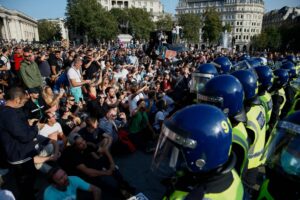 in London’s Trafalgar Square. As a result of the violence, the police wanted to set up a temporary police station, so they could keep an eye on things. The public would have none of it. Their outcry literally caused the police to drop the project. The problem, however, remained, so they knew that something had to be done. Finally, someone came up with a brilliant idea. That year, they built several large ornate light posts. One of the light posts was configured with the idea of housing what is most likely the world’s tiniest police station. This brilliant idea allowed the police to hide it, and their surveillance, in plain sight.
in London’s Trafalgar Square. As a result of the violence, the police wanted to set up a temporary police station, so they could keep an eye on things. The public would have none of it. Their outcry literally caused the police to drop the project. The problem, however, remained, so they knew that something had to be done. Finally, someone came up with a brilliant idea. That year, they built several large ornate light posts. One of the light posts was configured with the idea of housing what is most likely the world’s tiniest police station. This brilliant idea allowed the police to hide it, and their surveillance, in plain sight.
The police station pole was located inconspicuously at the south-east corner of Trafalgar Square. It is a rather 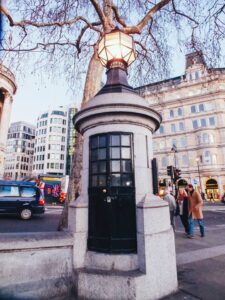 peculiar and often overlooked world record holder…Britain’s Smallest Police Station. Apparently this tiny box can accommodate up to two prisoners at a time, although its main purpose was to hold a single police officer. I guess you could say that it was a 1920’s version of the ring doorbell camera. It didn’t take video, but the officer inside could clearly watch the square. Once the light fitting was hollowed out, the builders installed a set of narrow windows in order to provide a vista across the main square. Also installed was a direct phone line back to Scotland Yard in case reinforcements were needed in times of trouble. In fact, whenever the police phone was picked up, the ornamental light fitting at the top of the box started to flash, alerting any nearby officers on duty that trouble was near. It was a brilliant idea, but as with all inventions, their usefulness lasts only until the next big thing comes along. Such was the case with the Trafalgar Square Light Pole Police Station. Eventually new technology made the little station obsolete. Today the pole is used for custodial storage.
peculiar and often overlooked world record holder…Britain’s Smallest Police Station. Apparently this tiny box can accommodate up to two prisoners at a time, although its main purpose was to hold a single police officer. I guess you could say that it was a 1920’s version of the ring doorbell camera. It didn’t take video, but the officer inside could clearly watch the square. Once the light fitting was hollowed out, the builders installed a set of narrow windows in order to provide a vista across the main square. Also installed was a direct phone line back to Scotland Yard in case reinforcements were needed in times of trouble. In fact, whenever the police phone was picked up, the ornamental light fitting at the top of the box started to flash, alerting any nearby officers on duty that trouble was near. It was a brilliant idea, but as with all inventions, their usefulness lasts only until the next big thing comes along. Such was the case with the Trafalgar Square Light Pole Police Station. Eventually new technology made the little station obsolete. Today the pole is used for custodial storage.
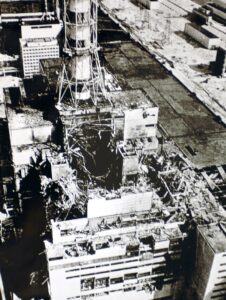 It seems an impossible task, to keep a disaster a secret, and yet that is exactly what the Soviet Union tried to do when disaster struck on April 26, 1986, at the No. 4 reactor in the Chernobyl Nuclear Power Plant, near the city of Pripyat in the north of the Ukrainian SSR. Chernobyl is considered the worst nuclear disaster in history. In terms of cost and casualties, and it is one of only two nuclear energy accidents rated at seven, which is the maximum severity, on the International Nuclear Event Scale. The other disaster was the well known 2011 Fukushima Daiichi nuclear disaster in Japan that was caused by a tsunami.
It seems an impossible task, to keep a disaster a secret, and yet that is exactly what the Soviet Union tried to do when disaster struck on April 26, 1986, at the No. 4 reactor in the Chernobyl Nuclear Power Plant, near the city of Pripyat in the north of the Ukrainian SSR. Chernobyl is considered the worst nuclear disaster in history. In terms of cost and casualties, and it is one of only two nuclear energy accidents rated at seven, which is the maximum severity, on the International Nuclear Event Scale. The other disaster was the well known 2011 Fukushima Daiichi nuclear disaster in Japan that was caused by a tsunami.
On April 28, 1986, two days after monitoring stations in Sweden, Finland and Norway began reporting sudden high discharges of radioactivity in the atmosphere, the Soviet Union finally broke the news by way of their official news agency, Tass. Two days!! In the realm of nuclear contamination, two days is an eternity!! When the Soviet Union finally told the world, Tass simply said there had been an accident at the Chernobyl nuclear power plant in Ukraine. They didn’t say they had tried to hide it, but two days of no response tells me they did. The initial emergency response, together with later decontamination of the environment, ultimately involved more than 500,000 personnel and cost an estimated 18 billion Soviet rubles, which is roughly $68 billion US dollars as of the dollar value in 2019.
It was determined that the accident had started during a safety test on an RBMK-type nuclear reactor. During testing a simulation of an electrical power outage was used to help create a safety procedure for maintaining reactor cooling water circulation until the back-up electrical generators could provide power. These units had been tested three times since 1982, but they had failed to provide a solution. On this fourth attempt, an unexpected 10-hour delay meant that an unprepared operating shift was on duty. The power unexpectedly dropped to a near-zero level during the planned decrease of reactor power in preparation for the electrical test. The operators were only able to partially restore the specified test power, putting the reactor in an unstable condition. This risk was not made evident in the operating instructions, so the operators proceeded with the electrical test. Upon test completion, the operators triggered a reactor shutdown, but a combination of unstable conditions and reactor design flaws caused an uncontrolled nuclear chain reaction instead.
The failure caused a large amount of energy to be suddenly released, followed by two explosions that ruptured 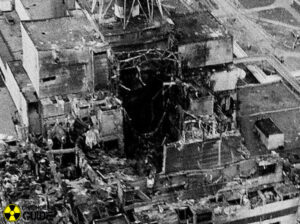 the reactor core and destroyed the reactor building. One was a highly destructive steam explosion from the vaporizing superheated cooling water. The other explosion could have been another steam explosion or a small nuclear explosion, like a nuclear fizzle. The explosions were followed immediately by an open-air reactor core fire that released considerable airborne radioactive contamination for about nine days. The contamination fell onto parts of the USSR and western Europe, especially 10 miles away in Belarus, where around 70% landed, before finally being contained on May 4, 1986. In addition to the contamination released by the explosions, the fire gradually released about the same amount of contamination as did the initial explosion. As a result of rising radiation levels in surrounding regions, a 6.2 mile radius exclusion zone was created 36 hours after the accident. About 49,000 people were evacuated from the area, primarily the citizens of Pripyat. Later the exclusion zone was increased to 19 mile radius, and an additional 68,000 people were evacuated from the wider area.
the reactor core and destroyed the reactor building. One was a highly destructive steam explosion from the vaporizing superheated cooling water. The other explosion could have been another steam explosion or a small nuclear explosion, like a nuclear fizzle. The explosions were followed immediately by an open-air reactor core fire that released considerable airborne radioactive contamination for about nine days. The contamination fell onto parts of the USSR and western Europe, especially 10 miles away in Belarus, where around 70% landed, before finally being contained on May 4, 1986. In addition to the contamination released by the explosions, the fire gradually released about the same amount of contamination as did the initial explosion. As a result of rising radiation levels in surrounding regions, a 6.2 mile radius exclusion zone was created 36 hours after the accident. About 49,000 people were evacuated from the area, primarily the citizens of Pripyat. Later the exclusion zone was increased to 19 mile radius, and an additional 68,000 people were evacuated from the wider area.
When the reactor exploded, two of the reactor operating staff lost their lives instantly. Crews rushed to put out the fire, stabilize the reactor, and cleanup the ejected nuclear core. As a result of the disaster and immediate response, 134 station staff and firemen were hospitalized with acute radiation syndrome due to absorbing high doses of ionizing radiation. In the days to months afterward 28 of these 134 people died, and approximately 14 suspected radiation-induced cancer deaths followed within the next 10 years. Significant cleanup operations were taken in the exclusion zone to deal with local fallout, and the exclusion zone was made permanent. The cities in the zone remain abandoned.
By 2011, an excess of 15 childhood thyroid cancer deaths were documented among the wider population. The United Nations Scientific Committee on the Effects of Atomic Radiation (UNSCEAR) has reviewed all the published research on the incident multiple times, and found that at present, fewer than 100 documented deaths are likely to be attributable to increased exposure to radiation. Of course, there is no way to be sure of that information, because “determining the total eventual number of exposure related deaths is uncertain based on the linear no-threshold model, a contested statistical model, which has also been used in estimates of low level radon and air pollution exposure.” When the expected deaths is viewed in “model predictions with the greatest confidence values of the eventual total death toll in the decades ahead from Chernobyl releases vary, from 4,000 fatalities when solely assessing the three most contaminated former Soviet states, to about 9,000 to 16,000 fatalities when assessing the total continent of Europe. In an effort to reduce the spread of radioactive contamination from the wreckage and protect it from weathering, the protective Chernobyl Nuclear 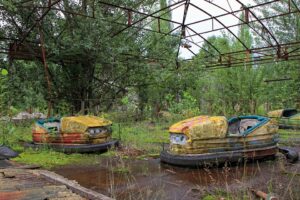 Power Plant sarcophagus was built by December 1986. It also provided radiological protection for the crews of the undamaged reactors at the site, which continued operating. Due to the continued deterioration of the sarcophagus, it was further enclosed in 2017 by the Chernobyl New Safe Confinement, a larger enclosure that allows the removal of both the sarcophagus and the reactor debris, while containing the radioactive hazard. Nuclear clean-up is scheduled for completion in 2065.” It is my opinion that if they had acted immediately to evacuate the people in surrounding areas, they might have reduced the number of deaths substantially. Keeping the accident a secret for two days was insane, and very likely criminal.
Power Plant sarcophagus was built by December 1986. It also provided radiological protection for the crews of the undamaged reactors at the site, which continued operating. Due to the continued deterioration of the sarcophagus, it was further enclosed in 2017 by the Chernobyl New Safe Confinement, a larger enclosure that allows the removal of both the sarcophagus and the reactor debris, while containing the radioactive hazard. Nuclear clean-up is scheduled for completion in 2065.” It is my opinion that if they had acted immediately to evacuate the people in surrounding areas, they might have reduced the number of deaths substantially. Keeping the accident a secret for two days was insane, and very likely criminal.

 The race to space was not without the unfortunate casualties here and there. Nevertheless, as a whole, it has been a very safe program. The first deaths experienced by the United States, in the NASA program were those of Command Pilot Gus Grissom, Senior Pilot Ed White, and Pilot Roger Chaffee on January 27, 1967, when he Command Module interior caught fire and burned, during a pre-launch test on Launch Pad 34 at Cape Kennedy. At that time there was no interior latch, so the men could not escape the burning module. It was a terrible tragedy for the NASA program and the nation as a whole. The United States had been involved in a “race to space” with the Soviet Union, and the fire was a terrible setback…not to mention the horrific loss of life.
The race to space was not without the unfortunate casualties here and there. Nevertheless, as a whole, it has been a very safe program. The first deaths experienced by the United States, in the NASA program were those of Command Pilot Gus Grissom, Senior Pilot Ed White, and Pilot Roger Chaffee on January 27, 1967, when he Command Module interior caught fire and burned, during a pre-launch test on Launch Pad 34 at Cape Kennedy. At that time there was no interior latch, so the men could not escape the burning module. It was a terrible tragedy for the NASA program and the nation as a whole. The United States had been involved in a “race to space” with the Soviet Union, and the fire was a terrible setback…not to mention the horrific loss of life.
On April 24, 1967, just a few short months later, the Soviet Union also experienced a tragic set back, when Soviet Cosmonaut Vladimir Komarov is killed when his parachute failed to deploy during his spacecraft’s landing. Komarov, a fighter pilot and aeronautical engineer, was testing the spacecraft Soyuz I at the time of the catastrophic failure of the parachute. He had made his first space trip in 1964, three years before the doomed 1967 voyage. After 24 hours and 16 orbits of the earth in Soyuz I, Komarov was scheduled to reenter the atmosphere, but ran into difficulty handling the vessel and was unable to fire the rocket brakes. It took two more trips around the earth before the cosmonaut could manage reentry. When Soyuz I reached an altitude of 23,000 feet, a parachute was supposed to deploy, bringing Komarov safely to earth. Unfortunately, the maneuvering problems he had caused the lines of the chute had gotten tangled and there was no backup chute. When Soyuz I reached an altitude of 23,000 feet, a parachute was supposed to deploy, bringing Komarov safely to earth. Komarov plunged to the ground and was killed.
Things in the Soviet Union were different than in the United States, and Komarov’s wife had not been told of the Soyuz I launch until after Komarov was already in orbit. Sadly, she did not get to say goodbye to her husband. Komarov was considered a national hero, and there was vast public mourning in Moscow. Komarov’s 
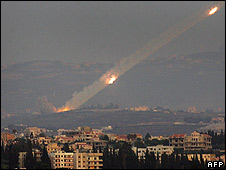 ashes were buried in the wall of the Kremlin. Space flight is dangerous, a fact that is well known to all who venture into its corridors. Despite the dangers, both the Soviet Union and the United States continued their space exploration. The United States landed men on the moon just two years later. Everyone was determined to see the program through, as they continue to be to this day.
ashes were buried in the wall of the Kremlin. Space flight is dangerous, a fact that is well known to all who venture into its corridors. Despite the dangers, both the Soviet Union and the United States continued their space exploration. The United States landed men on the moon just two years later. Everyone was determined to see the program through, as they continue to be to this day.
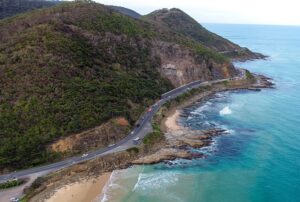
 There are many trails or roads that stretch across this world that seem to be simply a way to get from point A to point B, and indeed, that is what many of them are, but there are some that hold a very different meaning. One such road is the Great Ocean Road in southern Australia. The Great Ocean Road is an Australian National Heritage listed 151 mile stretch of road along the south-eastern coast of Australia between the Victorian cities of Torquay and Allansford. The road was built by soldiers who had returned from war between 1919 and 1932 and dedicated to soldiers killed during World War I. The Great Ocean Road is the world’s largest war memorial. It is an interesting kind of memorial, winding through varying terrain along the coast and providing access to several prominent landmarks, including the Twelve Apostles limestone stack formations. The road is an important tourist attraction in the region.
There are many trails or roads that stretch across this world that seem to be simply a way to get from point A to point B, and indeed, that is what many of them are, but there are some that hold a very different meaning. One such road is the Great Ocean Road in southern Australia. The Great Ocean Road is an Australian National Heritage listed 151 mile stretch of road along the south-eastern coast of Australia between the Victorian cities of Torquay and Allansford. The road was built by soldiers who had returned from war between 1919 and 1932 and dedicated to soldiers killed during World War I. The Great Ocean Road is the world’s largest war memorial. It is an interesting kind of memorial, winding through varying terrain along the coast and providing access to several prominent landmarks, including the Twelve Apostles limestone stack formations. The road is an important tourist attraction in the region.
The road would likely have been a huge tourist attraction, without the memorial as part of the attraction. I has gorgeous views of the ocean, as well as lighthouses along the way. It can be driven the entire way, but there are trails to walk along it as well, which would really be the thing I would find interesting. Along the way you can see limestone formations like the Twelve Apostles, but also one called the London Arch. It used to be the London Bridge, so I wonder if it was connected to the land at one time. The area has also been well known for shipwrecks, in fact, it is called the Shipwreck Coast. Ships wrecked there include Thistle (1837), Children (1839), Unknown French whaler (1841), Lydia (1843), Socrates (1843), Cataraqui (1845), Enterprise (1850), Essington (1852), Freedom (1853), SS Schomberg (built Liverpool, named after Charles Frederick Schomberg, sunk 1855), John Scott (1858), Golden Spring (1863), Marie Gabrielle (1869), Young Australian (1877), Loch Ard (1878), Napier (1878), Alexandra (1882), Yarra (1882), Edinburgh Castle (1888), Fiji (1891), Joseph H. Scammell (1891), Newfield (1892), Freetrader (1894), La Bella (1905), Falls of Halladale (1908), The Speculant (1911), Antares (1914), Casino (1932), and City of Rayville (1940), among others. Over 50 shipwrecks are commemorated in a Historic Shipwreck Trail beginning at Port Fairy.
There are a number of tourist attractions along the Great Ocean Road, besides the Shipwreck Coast west of Cape Otway, including the Surf Coast, between Torquay and Cape Otway, providing visibility of Bass Strait and the Southern Ocean. The road winds through rainforests, as well as beaches and cliffs made of limestone and 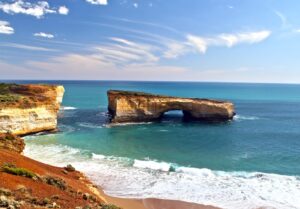
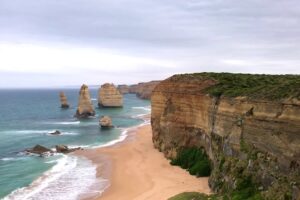 sandstone, which is susceptible to erosion…hence the limestone stacks. As the Great Ocean Road nears Geelong, the road moves along the coast, with tall, almost-vertical cliffs on the other side of it. Of course, there is the possibility of falling rocks, but it doesn’t deter the tourists. I have never had the pleasure of being a tourist along that beautiful stretch of road, but I really think I might enjoy it if I ever got the chance.
sandstone, which is susceptible to erosion…hence the limestone stacks. As the Great Ocean Road nears Geelong, the road moves along the coast, with tall, almost-vertical cliffs on the other side of it. Of course, there is the possibility of falling rocks, but it doesn’t deter the tourists. I have never had the pleasure of being a tourist along that beautiful stretch of road, but I really think I might enjoy it if I ever got the chance.

 Many people know that April 20th is Hitler’s birthday, not that most of us would celebrate that fact. Nevertheless, for the Allies in World War II, at least on April 20, 1945, that day meant something. Not because it was Hitler’s birthday…no, it was because the Allies had a plan. The Germans had been in control in much of Italy, and their advancement had to be stopped. As always, there were multiple campaigns planned on any given day in the war. One planned attack, called Operation Corncob, was to send Allied bombers into Italy to begin a three-day attack on the bridges over the rivers Adige and Brenta to cut off the German lines of possible retreat on the peninsula. They knew that Hitler would be otherwise occupied, it being his birthday and all…and so he was.
Many people know that April 20th is Hitler’s birthday, not that most of us would celebrate that fact. Nevertheless, for the Allies in World War II, at least on April 20, 1945, that day meant something. Not because it was Hitler’s birthday…no, it was because the Allies had a plan. The Germans had been in control in much of Italy, and their advancement had to be stopped. As always, there were multiple campaigns planned on any given day in the war. One planned attack, called Operation Corncob, was to send Allied bombers into Italy to begin a three-day attack on the bridges over the rivers Adige and Brenta to cut off the German lines of possible retreat on the peninsula. They knew that Hitler would be otherwise occupied, it being his birthday and all…and so he was.
Hitler was actually occupied for more reasons than just his birthday, as Soviet artillery had begun shelling Berlin at 11am on his 56th birthday. Preparations were being made to evacuate Hitler and his staff to Obersalzberg to make a final stand in the Bavarian mountains, but Hitler refused to leave his bunker. So, Hermann Göring and Heinrich Himmler left the bunker for the last time. Operation Herring had begun the day before, with American aircraft dropping Italian paratroopers over Northern Italy, and with Operation Corncob came the other half of the attack, which was to remove the bridges and thereby halt the expected retreat of the German forces. I doubt if Hitler knew anything about these attacks, I’m sure his mind was on his upcoming suicide, a death which some say didn’t really take place, and a fact which we will never know for sure.
The Allied attacks of April 1945 on the Italian front, were intended to end the Italian campaign and the war in Italy, and to decisively break through the German Gothic Line, the defensive line along the Apennines and the River Po plain to the Adriatic Sea and swiftly drive north to occupy Northern Italy and get to the Austrian and Yugoslav borders as quickly as possible. Unfortunately, German strongpoints, as well as bridge, road, levee and dike blasting, and any occasional determined resistance in the Po Valley plain slowed the planned sweep down. Allied planners decided that dropping paratroops into some key areas and locales south of the River Po might help wreak havoc in the German rear area, attack German communications, and vehicle columns, further disrupting the German retreat, and prevent German engineers from blowing up key structures before Allied spearheads could exploit them. Lieutenant General Sir Richard McCreery, commander of the Commonwealth 8th Army, had a number of Italian paratroopers at hand for the task.
Meanwhile, Adolf Hitler celebrated his 56th birthday with a traditional parade and full celebration, while a 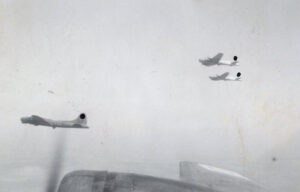
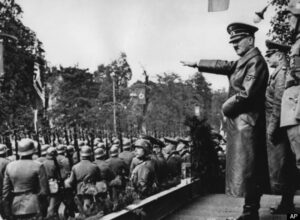 Gestapo reign of terror took the lives by hanging of 20 Russian prisoners of war and 20 Jewish children, at least nine of which were under the age of 12. All of the victims had been taken from Auschwitz to Neuengamme, the place of execution, for the purpose of medical experimentation. Hitler and his Third Reich didn’t fully understand it then, but they were finished, and the end was coming quickly.
Gestapo reign of terror took the lives by hanging of 20 Russian prisoners of war and 20 Jewish children, at least nine of which were under the age of 12. All of the victims had been taken from Auschwitz to Neuengamme, the place of execution, for the purpose of medical experimentation. Hitler and his Third Reich didn’t fully understand it then, but they were finished, and the end was coming quickly.

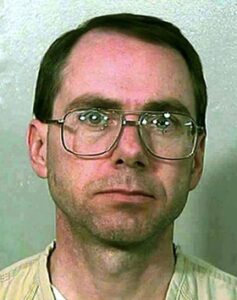 April 19, 1995 was a normal spring morning in Oklahoma City, Oklahoma, but by 9:02am, all that would change forever. This was the day that antigovernment extremists, Timothy McVeigh and Terry Nichols had chosen to tell the world that they didn’t like things going the way they were. The biggest problem was not that they wanted to protest, because that is their right, but it was the way they chose to protest that was completely criminal.
April 19, 1995 was a normal spring morning in Oklahoma City, Oklahoma, but by 9:02am, all that would change forever. This was the day that antigovernment extremists, Timothy McVeigh and Terry Nichols had chosen to tell the world that they didn’t like things going the way they were. The biggest problem was not that they wanted to protest, because that is their right, but it was the way they chose to protest that was completely criminal.
That morning, McVeigh parked a Ryder truck in front of the Alfred P Murrah Federal Building and then, he walked away. No warning was issued, because nothing was considered to be out of place, but that day about a thousand people started their day in the building, only to have their lives forever changed, or ended. The bomb went off at 9:02am, and in that moment, more than one-third of the building was destroyed, 168 people lost their lives, and about 800 were injured. The dead included 19 children in the on-site daycare facility. The blast destroyed or damaged 324 other buildings within a 16-block radius, shattered glass in 258 nearby buildings, and destroyed or burned 86 cars, causing an estimated $652 million worth of damage. In response to the attack, local, state, federal, and worldwide agencies quickly mobilized in extensive rescue. The Federal Emergency Management Agency (FEMA) activated 11 of its Urban Search and Rescue Task Forces, consisting of 665 rescue workers who assisted in rescue and recovery operations.
The investigation moved rapidly, and within 90 minutes of the explosion, McVeigh was stopped by Oklahoma Highway Patrolman Charlie Hanger for driving without a license plate and arrested for illegal weapons possession. It seems that most criminals make mistakes that lead to their downfall. Forensic evidence quickly 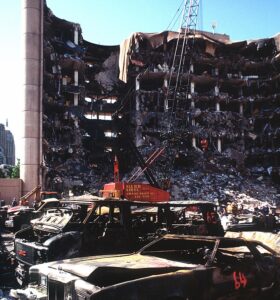
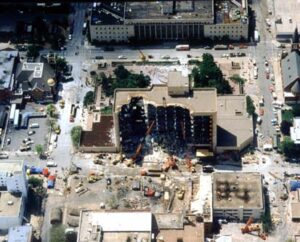 linked McVeigh and Nichols to the attacks. Nichols was arrested and within days, both were charged. Michael and Lori Fortier were later identified as co-conspirators. McVeigh, a veteran of the Gulf War and a sympathizer with the US militia movement, had detonated the Ryder rental truck filled with explosives and Nichols had assisted with the bomb’s preparation. Motivated by his dislike for the US federal government and unhappy about its handling of the Ruby Ridge incident in 1992 and the Waco siege in 1993, McVeigh timed his attack to coincide with the second anniversary of the fire that ended the siege at the Branch Davidian compound in Waco, Texas.
linked McVeigh and Nichols to the attacks. Nichols was arrested and within days, both were charged. Michael and Lori Fortier were later identified as co-conspirators. McVeigh, a veteran of the Gulf War and a sympathizer with the US militia movement, had detonated the Ryder rental truck filled with explosives and Nichols had assisted with the bomb’s preparation. Motivated by his dislike for the US federal government and unhappy about its handling of the Ruby Ridge incident in 1992 and the Waco siege in 1993, McVeigh timed his attack to coincide with the second anniversary of the fire that ended the siege at the Branch Davidian compound in Waco, Texas.
I could never understand why terrorists consider it necessary to take out so many innocent lives in order to make their grievances known. The official FBI investigation was known as “OKBOMB” involved 28,000 interviews, 3.5 short tons of evidence and nearly one billion pieces of information. The bombers were tried and convicted in 1997. McVeigh was sentenced to death, and was executed by lethal injection on June 11, 2001, at the US federal penitentiary in Terre Haute, Indiana. Nichols was sentenced to life in prison in 2004. Michael and Lori Fortier testified against McVeigh and Nichols, in exchange for a plea-deal. Michael Fortier was sentenced to 12 years in prison for failing to warn the United States government, and Lori received immunity from prosecution in exchange for her testimony. Michael was released into witness protection in 2006.
The US Congress passed the Antiterrorism and Effective Death Penalty Act of 1996, which tightened the standards for habeas corpus in the United States n response to the bombing. It also passed legislation to increase the protection around federal buildings to deter future terrorist attacks. Prior to the September 11th attacks in 2001, the Oklahoma City bombing was the deadliest terrorist attack in the history of the United 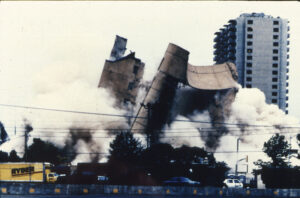
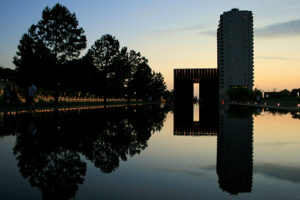 States, other than the Tulsa race massacre. It remains one of the deadliest acts of domestic terrorism in US history. On April 19, 2000, the Oklahoma City National Memorial was dedicated on the site of the Murrah Federal Building, commemorating the victims of the bombing. Remembrance services are held every year on April 19, at the time of the explosion.
States, other than the Tulsa race massacre. It remains one of the deadliest acts of domestic terrorism in US history. On April 19, 2000, the Oklahoma City National Memorial was dedicated on the site of the Murrah Federal Building, commemorating the victims of the bombing. Remembrance services are held every year on April 19, at the time of the explosion.

